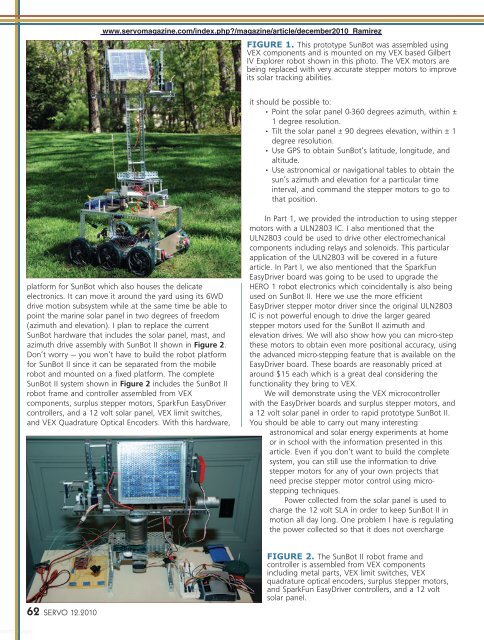You also want an ePaper? Increase the reach of your titles
YUMPU automatically turns print PDFs into web optimized ePapers that Google loves.
worldmags<br />
platform for SunBot which also houses the delicate<br />
electronics. It can move it around the yard using its 6WD<br />
drive motion subsystem while at the same time be able to<br />
point the marine solar panel in two degrees of freedom<br />
(azimuth <strong>and</strong> elevation). I plan to replace the current<br />
SunBot hardware that includes the solar panel, mast, <strong>and</strong><br />
azimuth drive assembly with SunBot II shown in Figure 2.<br />
Don’t worry — you won’t have to build the robot platform<br />
for SunBot II since it can be separated from the mobile<br />
robot <strong>and</strong> mounted on a fixed platform. The complete<br />
SunBot II system shown in Figure 2 includes the SunBot II<br />
robot frame <strong>and</strong> controller assembled from VEX<br />
components, surplus stepper motors, SparkFun EasyDriver<br />
controllers, <strong>and</strong> a 12 volt solar panel, VEX limit switches,<br />
<strong>and</strong> VEX Quadrature Optical Encoders. With this hardware,<br />
62 SERVO 12.2010<br />
www.servomagazine.com/index.php?/magazine/article/december2010_Ramirez<br />
FIGURE 1. This prototype SunBot was assembled using<br />
VEX components <strong>and</strong> is mounted on my VEX based Gilbert<br />
IV Explorer robot shown in this photo. The VEX motors are<br />
being replaced with very accurate stepper motors to improve<br />
its solar tracking abilities.<br />
it should be possible to:<br />
• Point the solar panel 0-360 degrees azimuth, within ±<br />
1 degree resolution.<br />
• Tilt the solar panel ± 90 degrees elevation, within ± 1<br />
degree resolution.<br />
• Use GPS to obtain SunBot’s latitude, longitude, <strong>and</strong><br />
altitude.<br />
• Use astronomical or navigational tables to obtain the<br />
sun’s azimuth <strong>and</strong> elevation for a particular time<br />
interval, <strong>and</strong> comm<strong>and</strong> the stepper motors to go to<br />
that position.<br />
In Part 1, we provided the introduction to using stepper<br />
motors with a ULN2803 IC. I also mentioned that the<br />
ULN2803 could be used to drive other electromechanical<br />
components including relays <strong>and</strong> solenoids. This particular<br />
application of the ULN2803 will be covered in a future<br />
article. In Part I, we also mentioned that the SparkFun<br />
EasyDriver board was going to be used to upgrade the<br />
HERO 1 robot electronics which coincidentally is also being<br />
used on SunBot II. Here we use the more efficient<br />
EasyDriver stepper motor driver since the original ULN2803<br />
IC is not powerful enough to drive the larger geared<br />
stepper motors used for the SunBot II azimuth <strong>and</strong><br />
elevation drives. We will also show how you can micro-step<br />
these motors to obtain even more positional accuracy, using<br />
the advanced micro-stepping feature that is available on the<br />
EasyDriver board. These boards are reasonably priced at<br />
around $15 each which is a great deal considering the<br />
functionality they bring to VEX.<br />
We will demonstrate using the VEX microcontroller<br />
with the EasyDriver boards <strong>and</strong> surplus stepper motors, <strong>and</strong><br />
a 12 volt solar panel in order to rapid prototype SunBot II.<br />
You should be able to carry out many interesting<br />
astronomical <strong>and</strong> solar energy experiments at home<br />
or in school with the information presented in this<br />
article. Even if you don’t want to build the complete<br />
system, you can still use the information to drive<br />
stepper motors for any of your own projects that<br />
need precise stepper motor control using microstepping<br />
techniques.<br />
Power collected from the solar panel is used to<br />
charge the 12 volt SLA in order to keep SunBot II in<br />
motion all day long. One problem I have is regulating<br />
the power collected so that it does not overcharge<br />
FIGURE 2. The SunBot II robot frame <strong>and</strong><br />
controller is assembled from VEX components<br />
including metal parts, VEX limit switches, VEX<br />
quadrature optical encoders, surplus stepper motors,<br />
<strong>and</strong> SparkFun EasyDriver controllers, <strong>and</strong> a 12 volt<br />
solar panel.<br />
worldmags




